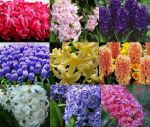
|
||
|
|
|
|
| Forgot Password | ||
Facts on Hyacinths
Posted by ESEM |
Added on : April 09, 2010 05:40am |
Last edited: June 14, 2010 04:17am | Viewed 3509 times
| 0 Comments | This article is also in blooms
and blooms
Common Hyacinth (Hyacinthus orientalis), whose flowers open fully and look like little starfish, should not be confused with common grape Hyacinth flowers (Muscari botryoides).
Common grape Hyacinth bears tight blooms in a raceme resembling clusters of grapes. Both are spring-blooming bulb plants.
Hyacinths are spring-flowering bulbs with long, narrow leaves that are folded lengthwise. Hyacinths are highly fragrant flowers that bloom in dense clusters.
Hyacinth is the common name for approximately 30perennial flowering plants of the genus Hyacinthus (order Liliales, family Liliaceae) of the Mediterranean region and
The common garden Hyacinth, Hyacinth orientalis, originated in Anatolia and was brought to
Hyacinth are highly fragrant, bell-shaped flowers with reflexed petals. The waxy, densely-packed florets come in shades of white, peach, orange, salmon, yellow, pink, red, purple, lavender and blue.
The 7-8 leaves are strap shaped, and a fleshy, glossy green. The Hyacinth bulb is a light purple or cream in color and covered with dry, papery, skin-like layers.
 There are varieties of hyacinths. The first is the Single Hyacinths. The full heads on these classic hyacinths look good in the garden or forced in pots. Blue Giant is one of the largest singles, and has sky blue flowers with dark blue veins. Another varietyis the Double Hyacinths. Fluffy whorls of colorful flowers are arranged on 10-12 inch stems. Hollyhock is an outstanding variety that features dark pink blooms. The other variety is Multiflora Hyacinths. Each bulb produces a number of flower stalks with loose arrangements of flowers. These are less formal than singles and doubles.
There are varieties of hyacinths. The first is the Single Hyacinths. The full heads on these classic hyacinths look good in the garden or forced in pots. Blue Giant is one of the largest singles, and has sky blue flowers with dark blue veins. Another varietyis the Double Hyacinths. Fluffy whorls of colorful flowers are arranged on 10-12 inch stems. Hollyhock is an outstanding variety that features dark pink blooms. The other variety is Multiflora Hyacinths. Each bulb produces a number of flower stalks with loose arrangements of flowers. These are less formal than singles and doubles.
To grow hyacinths plant hyacinth bulbs in fall, 6 to 8 weeks before a hard frost is expected and when soils are below 60 degrees F. This is usually during September and October in the North, and October and November in the South. Prepare the garden bed by using a garden fork or tiller to loosen the soil to a depth of 12 to 15 inches, then mix in a 2- to 4-inch layer of compost. Dig a hole 6 to 8 inches deep. Set the bulb in the hole, pointy end up, then cover with soil and press firmly. Space bulbs 4 to 6 inches apart. Water thoroughly after planting.
After they bloom in spring, allow the plants to grow until the leaves die off. They need time after blooming to store energy in the bulbs for next year. To remove the dead plant, either snip them off at the base, or twist the leaves while pulling lightly.
Keep Hyacinths watered during dry spells in the fall. After the plants are finished flowering in spring, cut back flower stalks but allow the leaves to die back naturally, hiding the unsightly foliage with annual or perennial plantings. An annual application of compost should provide adequate nutrients. Flower size may decline in subsequent years, so some gardeners treat Hyacinths as annuals and plant fresh bulbs each fall.
Summer Hyacinths bear fragrant, bell-shaped flowers for a month in mid summer. If planted in March, you can expect blossoms in July. The Hyacinth bulb may be propagated vegetatively by removing the bulblets that have developed by the end of the growing season.



Be the first one to comment on this article